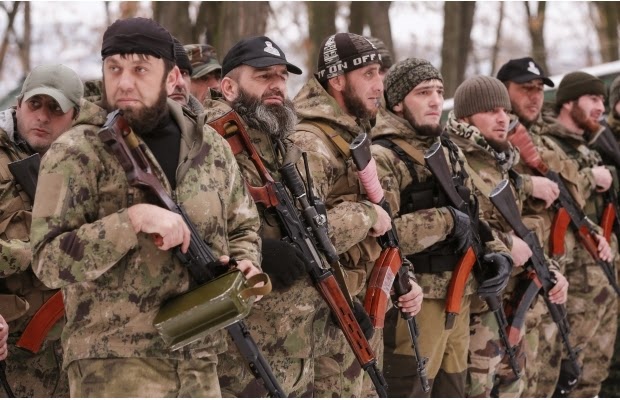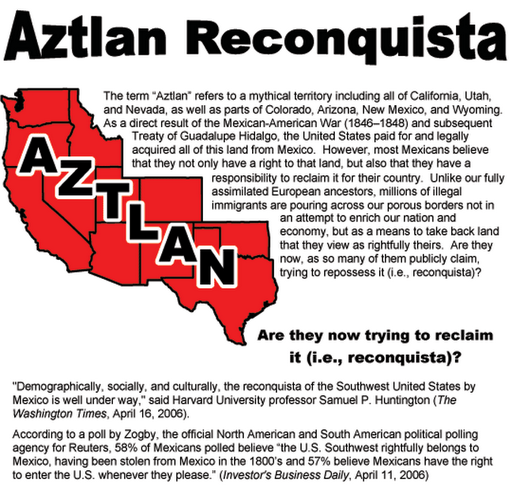The speaker of parliament of southwestern
Russia’s
Chechen Republic responded on March 24th to recent measures in the
United States Congress to arm
Ukraine against Russian aggression by
threatening to arm
Mexico for a
reconquista of vast territories the U.S. swiped in the 19th century.
The parliament speaker,
Dukvakha Abdurakhmanov, said in
a statement on the legislature’s website that that day’s 348-48 non-binding House of Representatives vote on supplying “lethal aid” to Ukraine was an overstepping of America’s bounds and that it was time to “resume debate on the legal status of the territories annexed by the U.S.,” including “
California,
New Mexico,
Arizona,
Nevada,
Utah,
Colorado, and a part of
Wyoming.” The statement added, “ We reserve the right to conduct conferences in Russia, Mexico and the U.S. to raise the question of breaking away the above mentioned states from the U.S., and [about] supplying weapons to resistance fighters there.”
![]() |
| The Chechen parliament speaker, Dukvakha Abdurakhmanov |
Dmitry Peskov, a spokesman for Russia’s president,
Vladimir Putin,
reminded Chechen leaders three days later that Russian law forbids arms sales abroad by individual constituent republics of the
Russian Federation. But the Kremlin pointedly did not distance itself from the underlying sentiment.
Chechnya fought and lost two brutal wars to secede from Russia after the fall of Communism, the second of which was spearheaded by Putin, punishing the tiny predominantly-Muslim nation with the most lethal and destructive bombing campaign in Europe since the Second World War (the
Yugoslav Wars of Succession didn’t even come close). Since then, Chechnya has been sealed off and under the iron fist of
Ramzan Kadyrov, the unelected, Putin-appointed dictator (and, ironically, former separatist rebel) who keeps the peace by toadying to the Kremlin and rewarding his citizens for their compliance with a form of Islamic law that, technically, flouts Russia’s secular constitution, including the reintroduction of polygamy, conservative clerics taking a leading role in public life, and the draining of public coffers to build football-stadium-sized mosques.
![]() |
The flag of the Chechen government-in-exile
(i.e., not the loonies that run the place now) |
Chechnya—along with other predominantly-Muslim Russian republics like
Ingushetia and
Tatarstan—came out fully in favor of Russia’s illegal invasion and annexation last year of Ukraine’s
Crimea peninsula (as discussed at the time in this blog; read articles
here and
here), even though these nations also have a history of suffering horribly under Russian imperialism and even though
Crimean Tatars, who are fellow Muslims, have gotten the worst of the Crimean annexation. Pro-Kremlin Chechen mercenaries are also active in the pro-Russian insurgencies in the self-proclaimed
Donetsk People’s Republic and
Lugansk People’s Republic in southeastern Ukraine, and it is widely understood that last month’s assassination of the Russian opposition leader
Boris Nemtsov was almost certainly carried out by Chechen special forces. Chechens, sadly, are the new
Cossacks.
![]() |
Chechen irregulars, from the imaginatively named “Death” battalion,
photographed recently in the Donetsk People’s Republic |
So does that mean that Kadyrov’s paramilitary reach is extending to, as Abdurakhmanov put it, “supplying weapons to resistance fighters” in formerly-Mexican parts of the U.S.? Well, probably not, since such a resistance movement doesn’t really exist. Sure, there have been publicity stunts. In 1966
Chicano activists inspired by the recent
American Indian Movement (
A.I.M.) standoff on
Alcatraz island, in San Francisco Bay, occupied part of the Kit Carson National Forest in northern New Mexico and declared it a
Republic of San Joaquín del Río de Chama. Around the same time, radical “
Brown Berets” modeled on the
Black Panthers took over
Santa Catalina Island off the coast of Southern California, claiming that it fell outside the Treaty of Guadalupe-Hidalgo, the 1848 agreement which cemented the American annexation of the northern half of Mexico after the Mexican-American War. And groups like the
Congreso de Aztlán and the student collective
Movimiento Estudiantil Chican@ de Aztlán (
MEChA, or, in English, the
Chicano/Chicana Student Movement of Aztlán) has advocated the idea of the southwestern United States becoming a Hispanic-ruled territory called
Aztlán (either as its own country or as part of Mexico). The former
University of New Mexico ethnic-studies professor
Charles Truxillo was in the 2000s calling for a new
Republica del Norte (“
Republic of the North”) including territories on both sides of the current U.S.–Mexican border. But never have any of these risen above the level of symbolic protest to become an actual movement.
![]() |
| A bit of right-wing propaganda about the (in fact, almost non-existent) Aztlán movement |
Nor is the Mexican government interested in taking up the issue, any more than it was when
Kaiser Wilhelm II made a similar offer in 1917, during the First World War, in a Berlin–Mexico City telegram intercepted by
U.K. intelligence. And let’s face it,
Germany’s military was already stretched a little thin at the time.
But pointing out the shaky ground America stands on when it comes to respect for territorial integrity is part of the Kremlin’s propaganda assault since the invasion of Ukraine last year. Just as Russia’s English-language
R.T. media network teems with the (
often right-wing, pro-Putin) separatist movements that plague western Europe—as an example of supposed European vulnerability on the topic—so, also, did the possibility of a Russian re-annexation of
Alaska become a “silly season” story of the week (discussed at the time in this blog
here and
here), and Russia’s lock-step foreign-policy allies in the Western Hemisphere,
Cuba and
Venezuela, have more than once called for U.S. decolonization of
Puerto Rico (
as reported on in this blog), even as they (
as this blog has also discussed) vote with Russia and against Ukraine in the
United Nations. The message seems to be: if the West thinks it can tell Russia what should be part of Russia and what shouldn’t, then we can play that game too.
![]() |
| Ramzan Kadyrov—wrapping Christmas presents for the Brown Berets? |
So far, it’s only talk, but
Springtime of Nations will be keeping you posted of any further developments.
![]() |
| Russian nationalists second that sentiment—or at least they pretend to in order to make a point |
[You can read more about Chechnya, Aztlán, the Donetsk People’s Republic, and other separatist movements, both famous and obscure, in my new book, a sort of encyclopedic atlas just published by Litwin Books under the title Let’s Split! A Complete Guide to Separatist Movements and Aspirant Nations, from Abkhazia to Zanzibar. The book, which contains 46 maps and 554 flags (or, more accurately, 554 flag images), is available for order now on Amazon. Meanwhile, please “like” the book (even if you haven’t read it yet) on Facebook and see this special announcement for more information on the book.]










